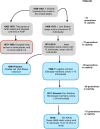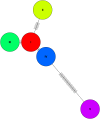Effective population sizes and adaptive genetic variation in a captive bird population
- PMID: 30356989
- PMCID: PMC6196071
- DOI: 10.7717/peerj.5803
Effective population sizes and adaptive genetic variation in a captive bird population
Abstract
Captive populations are considered a key component of ex situ conservation programs. Research on multiple taxa has shown the differential success of maintaining demographic versus genetic stability and viability in captive populations. In typical captive populations, usually founded by few or related individuals, genetic diversity can be lost and inbreeding can accumulate rapidly, calling into question their ultimate utility for release into the wild. Furthermore, domestication selection for survival in captive conditions is another concern. Therefore, it is crucial to understand the dynamics of population sizes, particularly the effective population size, and genetic diversity at non-neutral and adaptive loci in captive populations. In this study, we assessed effective population sizes and genetic variation at both neutral microsatellite markers, as well as SNP variants from the MHC-B locus of a captive Red Junglefowl population. This population represents a rare instance of a population with a well-documented history in captivity, following a realistic scenario of chain-of-custody, unlike many captive lab populations. Our analyses, which included 27 individuals comprising the entirety of one captive population show very low neutral and adaptive genetic variation, as well as low effective sizes, which correspond with the known demographic history. Finally, our study also shows the divergent impacts of small effective size and inbreeding in captive populations on microsatellite versus adaptive genetic variation in the MHC-B locus. Our study provides insights into the difficulties of maintaining adaptive genetic variation in small captive populations.
Keywords: Birds; Bottleneck; Captive population; Effective population size; Junglefowl; Major histocompatibility complex; Microsatellites.
Conflict of interest statement
The authors declare there are no competing interests.
Figures



Similar articles
-
Genetics driven interventions for ex situ conservation of red junglefowl (Gallus gallus murghi) populations in India.Zoo Biol. 2013 Sep-Oct;32(5):476-83. doi: 10.1002/zoo.21081. Epub 2013 Jun 28. Zoo Biol. 2013. PMID: 23813667
-
Population genetics and the effects of a severe bottleneck in an ex situ population of critically endangered Hawaiian tree snails.PLoS One. 2014 Dec 3;9(12):e114377. doi: 10.1371/journal.pone.0114377. eCollection 2014. PLoS One. 2014. PMID: 25470182 Free PMC article.
-
Long-term demographic and genetic effects of releasing captive-born individuals into the wild.Conserv Biol. 2019 Apr;33(2):377-388. doi: 10.1111/cobi.13217. Epub 2018 Dec 2. Conserv Biol. 2019. PMID: 30168872
-
Does reduced MHC diversity decrease viability of vertebrate populations?Biol Conserv. 2010 Mar;143(3):537-544. doi: 10.1016/j.biocon.2009.07.026. Epub 2009 Sep 11. Biol Conserv. 2010. PMID: 32226082 Free PMC article. Review.
-
Genetic adaptation to captivity in species conservation programs.Mol Ecol. 2008 Jan;17(1):325-33. doi: 10.1111/j.1365-294X.2007.03399.x. Mol Ecol. 2008. PMID: 18173504 Review.
Cited by
-
Take one step backward to move forward: Assessment of genetic diversity and population structure of captive Asian woolly-necked storks (Ciconia episcopus).PLoS One. 2019 Oct 10;14(10):e0223726. doi: 10.1371/journal.pone.0223726. eCollection 2019. PLoS One. 2019. PMID: 31600336 Free PMC article.
-
Influence of molecular marker type on estimating effective population size and other genetic parameters in a critically endangered parrot.Ecol Evol. 2024 Mar 24;14(3):e11102. doi: 10.1002/ece3.11102. eCollection 2024 Mar. Ecol Evol. 2024. PMID: 38524913 Free PMC article.
-
Reduced genetic variability in a captive-bred population of the endangered Hume's pheasant (Syrmaticus humiae, Hume 1881) revealed by microsatellite genotyping and D-loop sequencing.PLoS One. 2021 Aug 27;16(8):e0256573. doi: 10.1371/journal.pone.0256573. eCollection 2021. PLoS One. 2021. PMID: 34449789 Free PMC article.
-
Evolutionary pressures rendered by animal husbandry practices for avian influenza viruses to adapt to humans.iScience. 2022 Mar 1;25(4):104005. doi: 10.1016/j.isci.2022.104005. eCollection 2022 Apr 15. iScience. 2022. PMID: 35313691 Free PMC article. Review.
References
-
- Alcaide M, Negro JJ, Serrano D, Antolín JL, Casado S, Pomarol M. Captive breeding and reintroduction of the lesser kestrel Falco naumanni: a genetic analysis using microsatellites. Conservation Genetics. 2010;11:331–338. doi: 10.1007/s10592-009-9810-7. - DOI
Associated data
LinkOut - more resources
Full Text Sources
Research Materials
Miscellaneous

